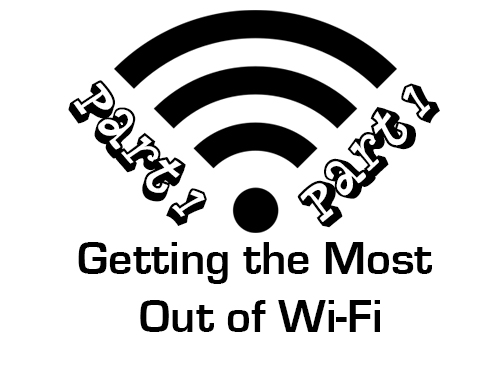
People often ask me how I come up with the topics for the posts that comprise the Finish Line Blog. One word: experience. Either I’ve been through these things myself, or customers or family members have done the heavy lifting for me. Lately, I’ve been fighting with Wi-Fi both at home and on the job. Everywhere you go, people expect access to wireless Internet, and most of them demand it be free. I’ll never forget the day I lost all faith in humanity. We were enjoying ice cream sundaes on a farm in Newtown, Connecticut (Ferris Acres Creamery, look it up) when a boy, about ten, was running around with a tablet in his hands, completely incensed that this ice cream stand on a farm had no Wi-Fi. As comedian Drew Carey once said, “Turn off the lights America, it’s all over!” I was right with Drew at that moment. Back on target, if you’re looking to set up your own wireless network at home, keep reading. Next week, we’ll help improve your signal strength and speed in part two.
In a time before wireless connections, the only way to connect a computer to the Internet was with a wire, specifically, an ethernet cord. An Ethernet cord has an RJ-45 plug on each end that looks like a large plug for a telephone jack. Ethernet cords are still an important part of a wireless connection today. Let me explain. For this example, we’ll pretend you have a cable Internet connection from your local cable company. The cable company has run a cable from outside your house into the house, and plugged it into the back of a cable modem. In this example, the cable company has provided only a modem and not a combination modem/router. Anyway, there’s only one plug for an Ethernet cord in the back of the modem. This situation provides you with two options: one, plug one end of the Ethernet cord into the the modem and the other end into a computer, or two, plug one end of the Ethernet cord into the modem and the other end into a router. If you’re looking for wireless Internet across your devices, you need a router to deliver that. What is a router? A network device that basically directs web “traffic” to each of your devices. So, what type of router should you buy? Let’s take a look.
As I often say, buying anything in the world of computers is like buying a car. Every person you talk to will have a different opinion of which brand to get! In keeping with that strategy, I won’t tell you which brand to buy, but I will tell you what you should look for. In today’s day and age, you’ll want to look into purchasing a dual-band router. A dual-band router operates on two different radio frequencies (2.4 GHz and 5.0 GHz) which is helpful in avoiding interference from microwaves, cordless phones, and Bluetooth devices which operate on 2.4 GHz. Less interference means more speed. Not all devices are currently able to run at 5.0 GHz, but the industry is trending that way so you’ll be ahead of the curve when it happens. The beauty of 5.0 GHz is that there’s more space between channels that reside at that frequency, so devices don’t interfere with each other except in most situations. You’ll also want to look into a router that uses 802.11ac technology which is the newest wireless protocol. These routers offer the most speed and channel options which is important for the reasons listed above.
After deciding on the perfect router for your situation, place it in the best location of your home. Ideally, the best location will be in the center of your home, away from metal and walls to allow Wi-Fi to travel the furthest. Connect an Ethernet cord from your modem to the router, power on the router, then connect a second Ethernet cord from the router to your computer to set it up. There are many different ways to set up a router, from a CD-Rom to web browser, so it’s best to follow the instructions that came with it. A couple of things to consider: one, security. Make sure to create a password for your router! If your router doesn’t have a password, anyone will be able to connect to your wireless network and eat up your bandwidth (speed) at best, or access personal files on your computers at worst. I can’t stress this enough: create a strong password that isn’t easily guessed! Second, create a guest network if possible. If there are guests in your home, connect them to the guest network so they can access only the Internet and not other computers or printers on your network. You can’t be too careful!
If you have DSL service or cable in a business, chances are you have a combination modem/router already giving you access to Wi-Fi. You can add a new router if you’re not getting the performance you’re expecting by following the steps laid out in this post. Most providers of combination units include the login information to access the router and configure its settings with a label on the outside. Some business plans require you to call your provider’s technical support line in order to make changes. Poke around and see which scenario you have. Wi-Fi is an extremely complicated subject, and we can go on forever talking about the various aspects of it. We’ll stop part one right here now that you’re up and running, and remind you to tune in next week for part two!
